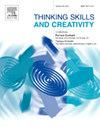加强计算思维评估:多模态认知诊断方法
IF 3.7
2区 教育学
Q1 Social Sciences
引用次数: 0
摘要
计算思维能力是学生适应数字社会的基本技能,而计算机思维能力的评估是提高学生计算机思维能力的关键。然而,目前对CT的评估是基于总结性的范式,在评估过程中忽略了CT的真实性能。因此,本研究采用基于情境任务中多模态数据的学生CT多模态认知诊断模型(H-MCDM),实现对学生CT掌握现状及认知行为特征的精准评估和探究。研究结果表明:1)学生CT在适度高水平表示的问题分解的CT组件和算法设计,但学生还没有掌握抽象的问题,2)共有六种不同的CT潜在模式在整个学生看见结果,3)个别学生共享相同的CT潜在的模式会有不同的认知和行为特征,而不同的CT潜在的模式可能有着类似的特征。本研究表明,通过相同或不同的CT潜在模式,可以在颗粒级上捕捉学生对CT的掌握程度及其认知和行为差异,为制定个性化的策略来提高学生的CT水平提供依据。本文章由计算机程序翻译,如有差异,请以英文原文为准。
Enhancing computational thinking assessment: A multimodal cognitive diagnostic approach
Computational thinking (CT) is an essential skill students need if they are to adapt to the rise of digital society, and the evaluation of CT is crucial for enhancing students’ CT. However, the current evaluation of CT is based on a summative paradigm and ignores real CT performance during the assessment process. This study thus used a multimodal cognitive diagnostic model (H-MCDM) of students’ CT based on multimodal data in situational tasks, to achieve precise evaluation and explore the current mastery status of students’ CT and their cognitive and behavioral characteristics. The research results indicate that: 1) students’ CT was at a moderately high level and indicated a good grasp of the CT components of problem decomposition and algorithm design, but students had not yet mastered problem abstraction, 2) a total of six different CT latent patterns were discerned in the overall student results, 3) individual students who shared the same CT latent patterns could differ in their cognitive and behavioral characteristics, while those with different CT latent patterns could share similar characteristics. This study showed that it is possible to capture the degree of students’ mastery of CT and their cognitive and behavioral differences with the same or different CT latent patterns at a granular level, providing a basis for developing individualized strategies to enhance students’ CT.
求助全文
通过发布文献求助,成功后即可免费获取论文全文。
去求助
来源期刊

Thinking Skills and Creativity
EDUCATION & EDUCATIONAL RESEARCH-
CiteScore
6.40
自引率
16.20%
发文量
172
审稿时长
76 days
期刊介绍:
Thinking Skills and Creativity is a new journal providing a peer-reviewed forum for communication and debate for the community of researchers interested in teaching for thinking and creativity. Papers may represent a variety of theoretical perspectives and methodological approaches and may relate to any age level in a diversity of settings: formal and informal, education and work-based.
 求助内容:
求助内容: 应助结果提醒方式:
应助结果提醒方式:


